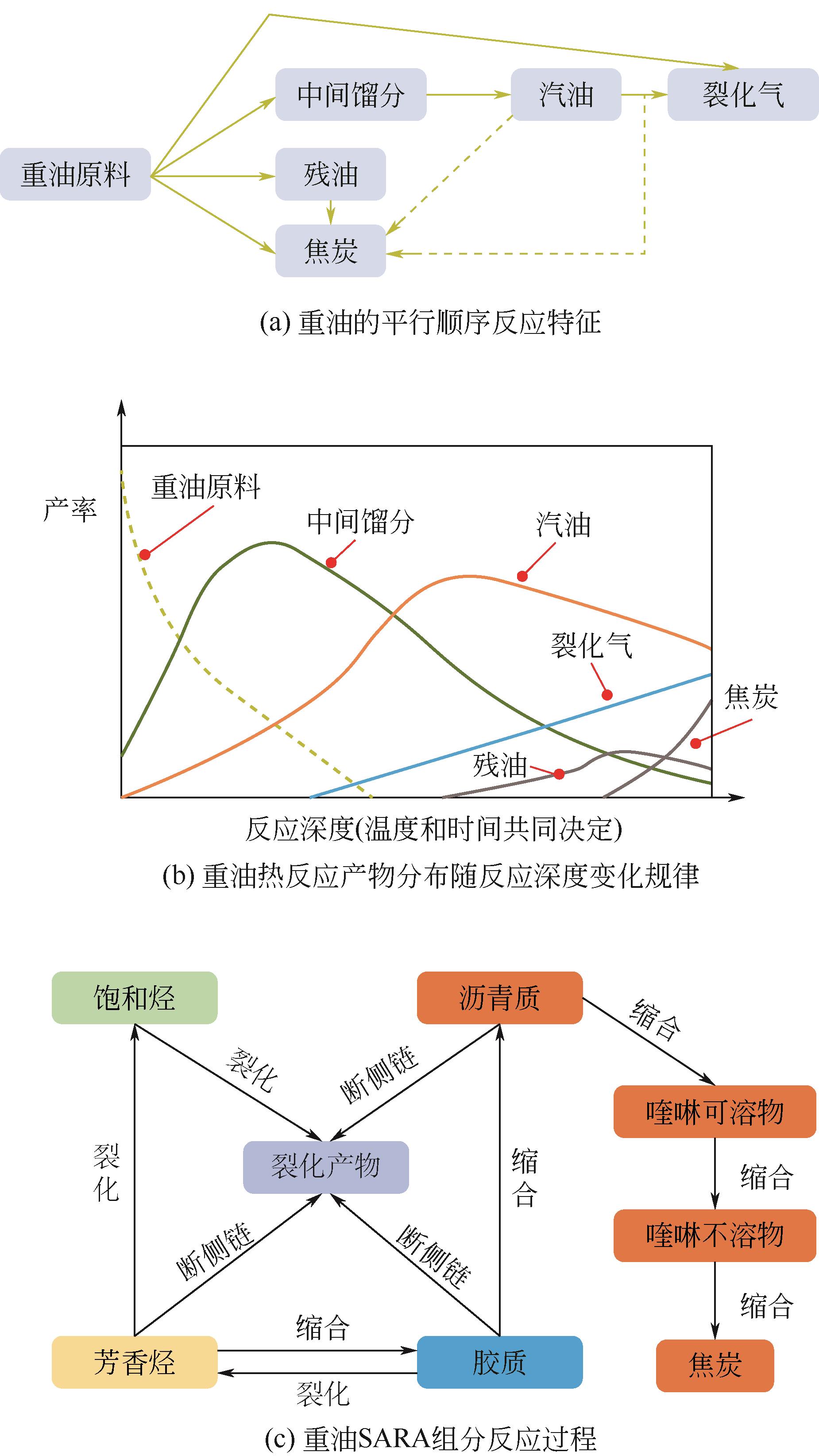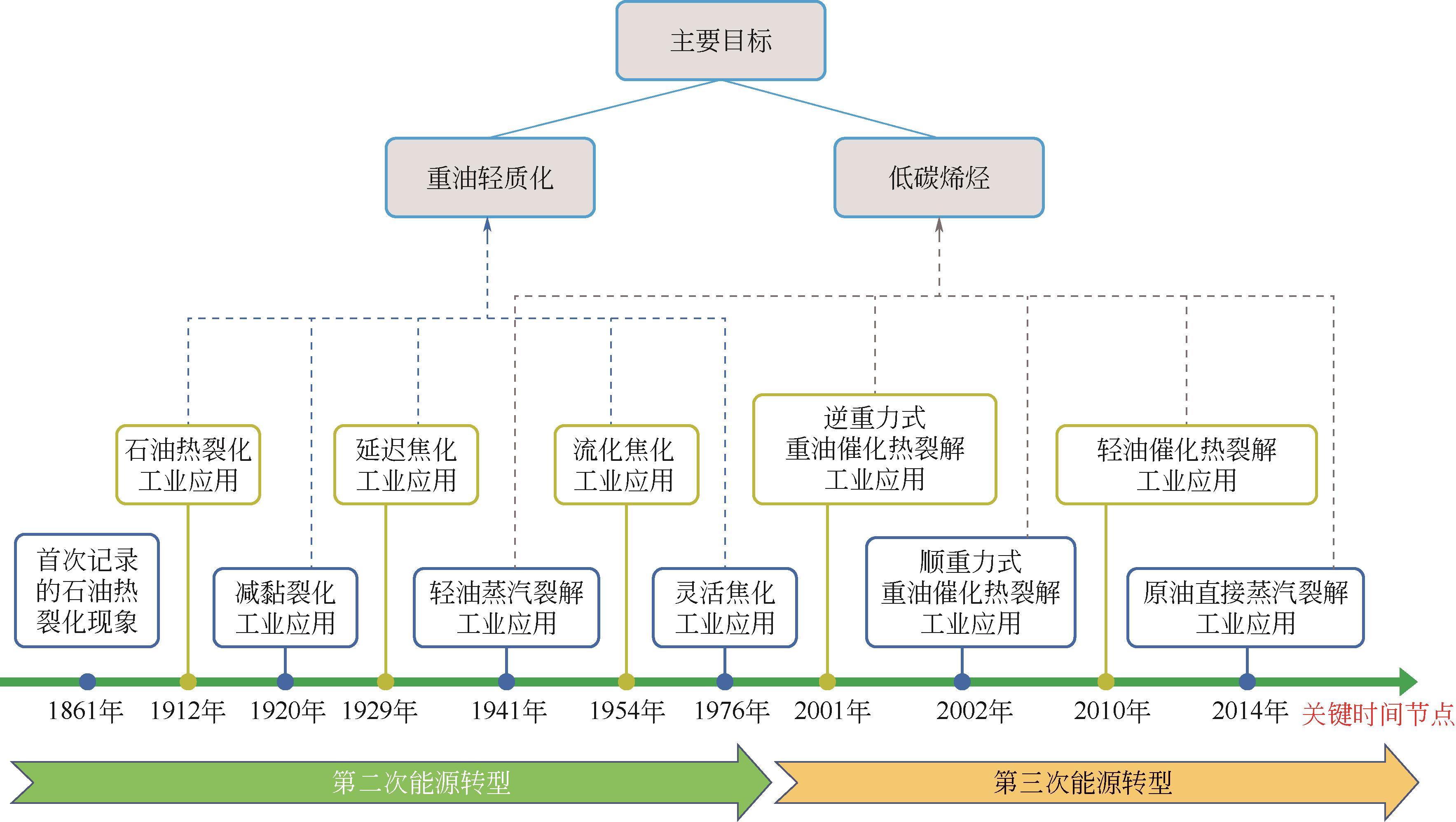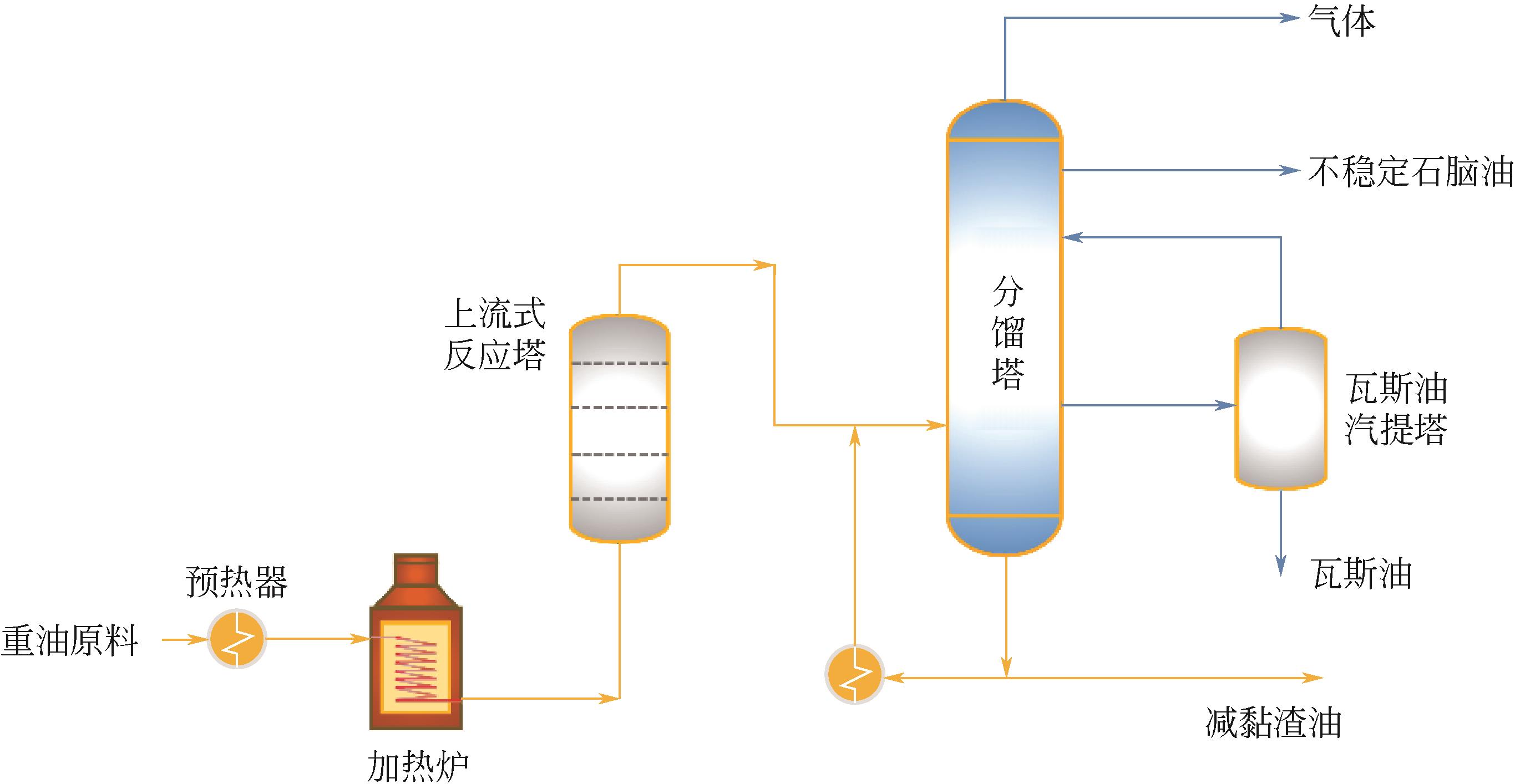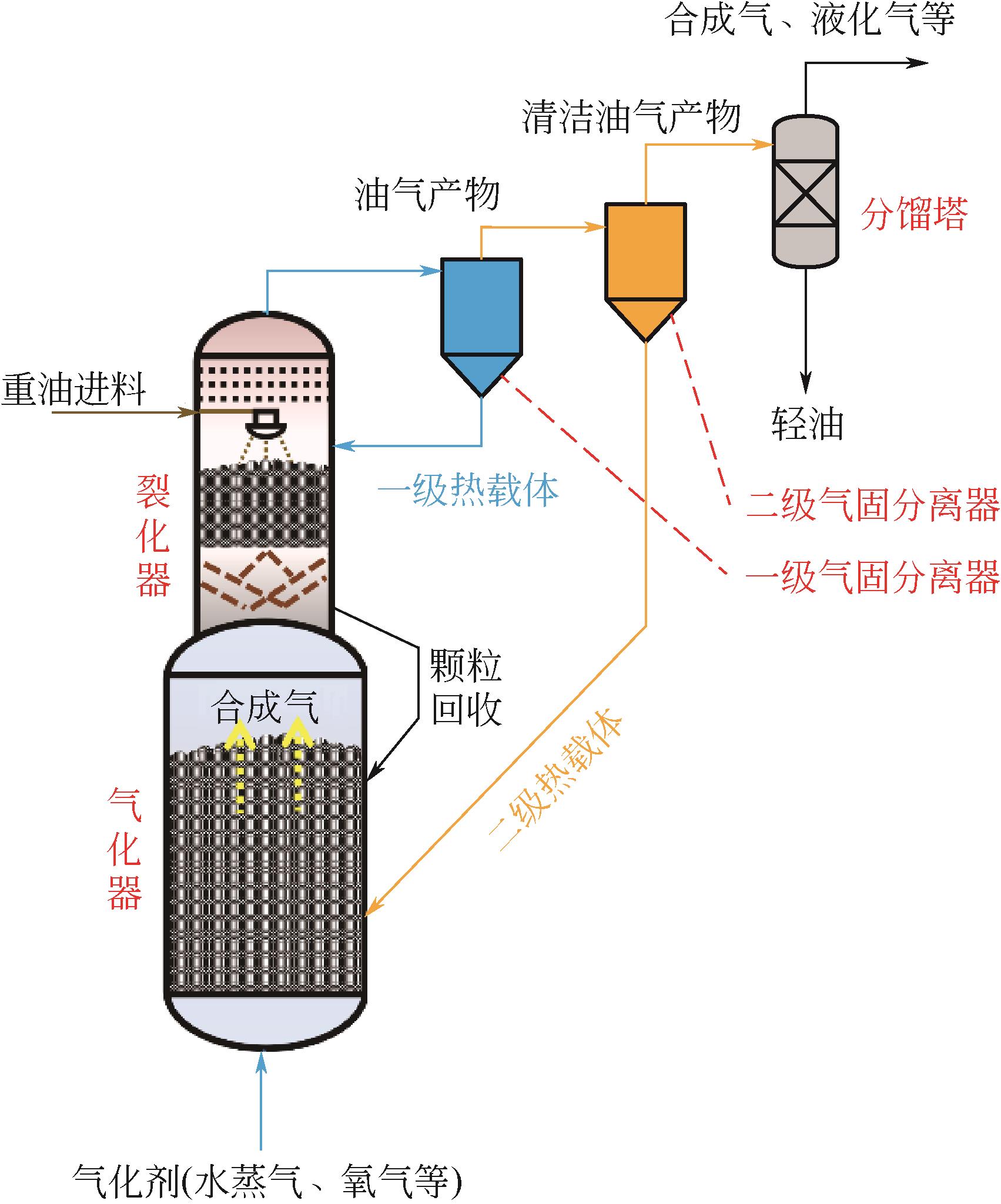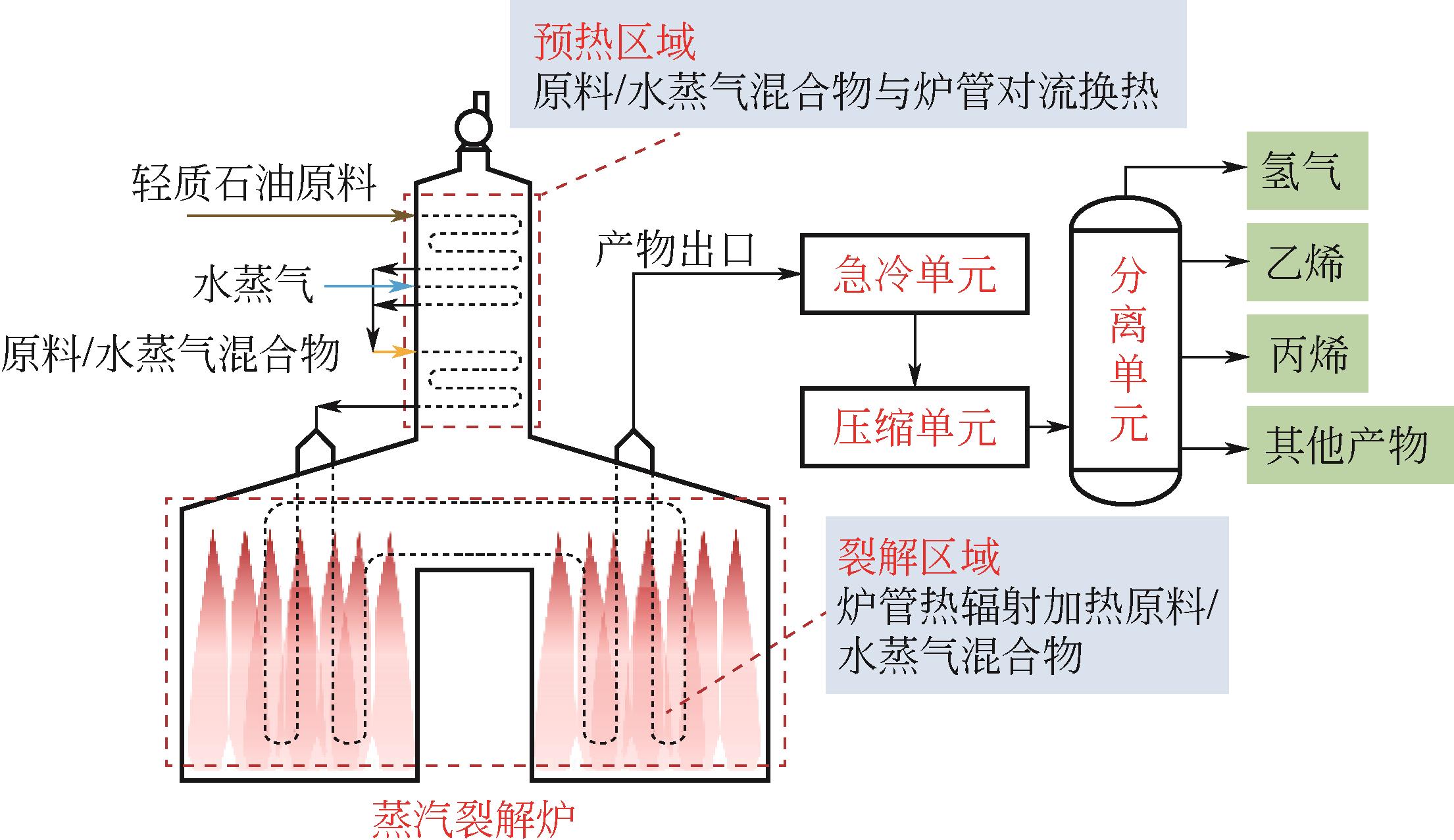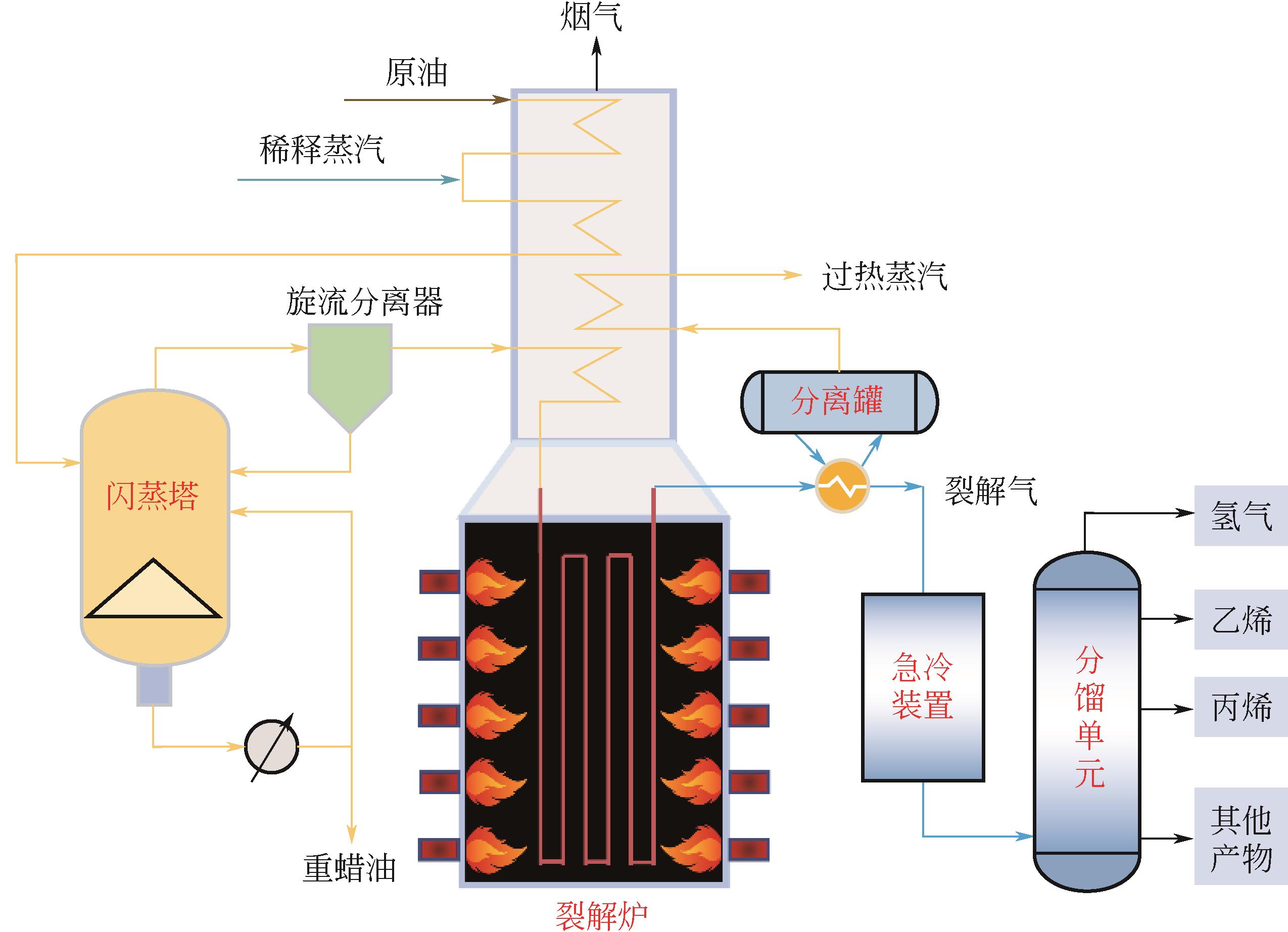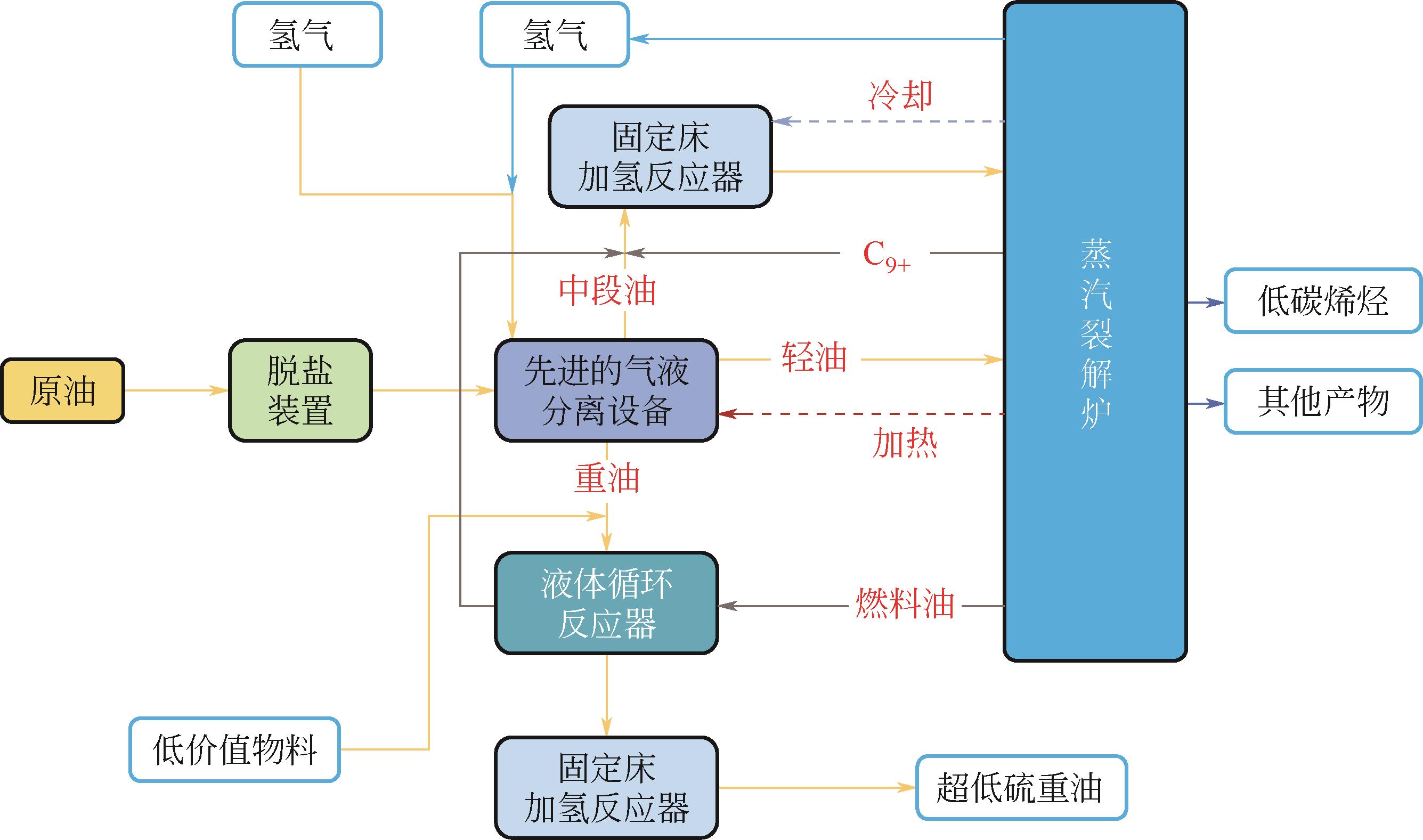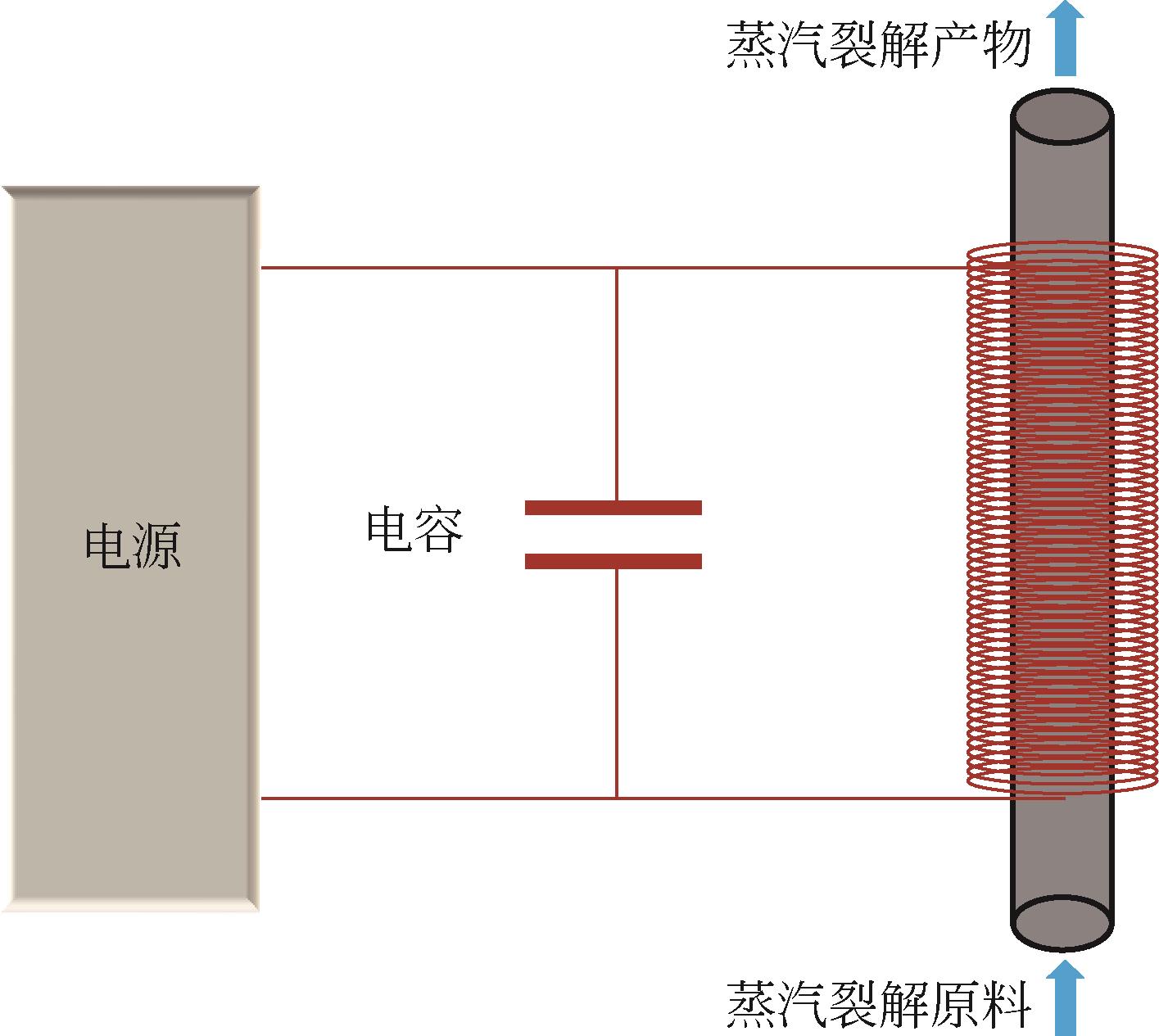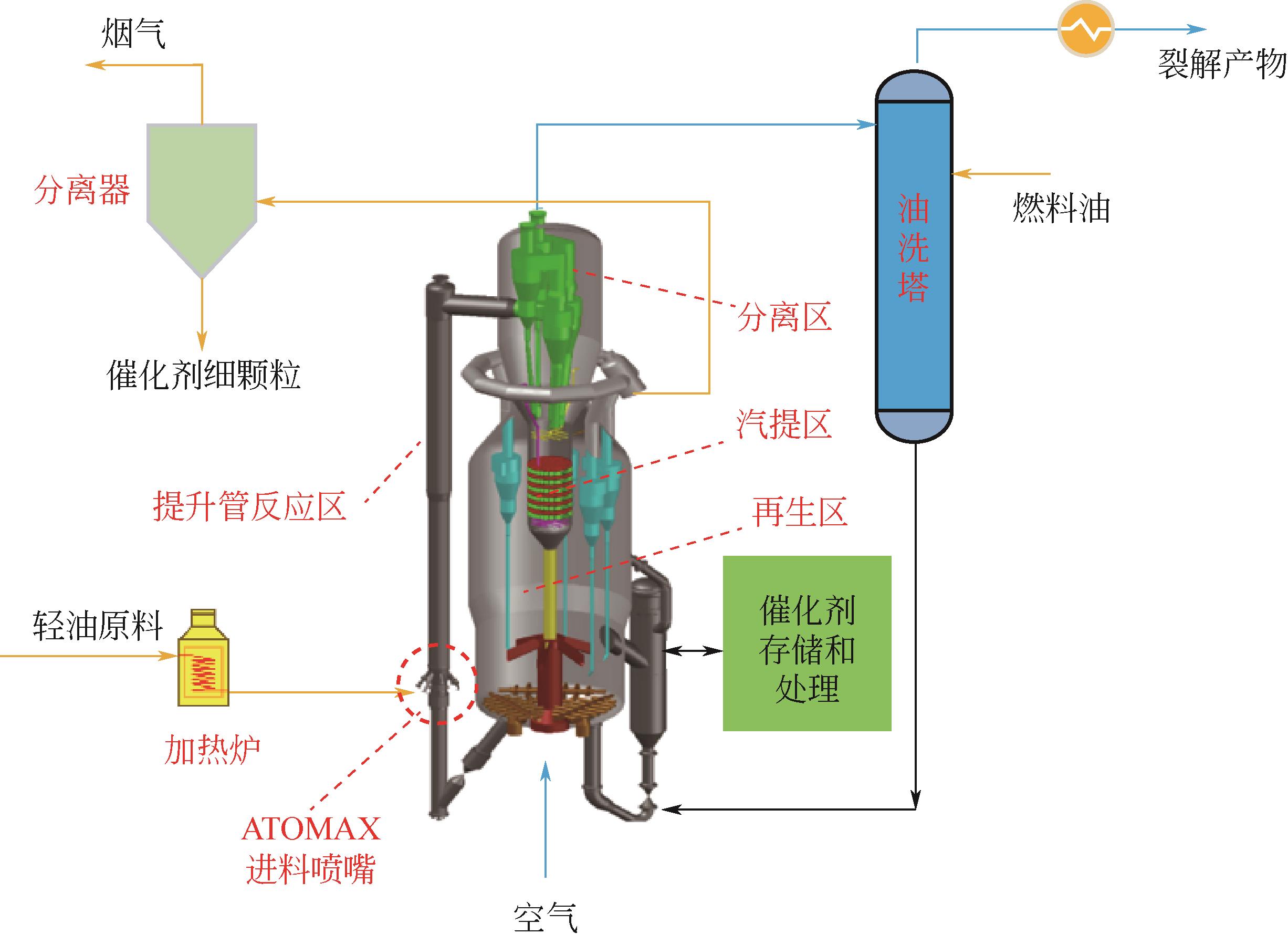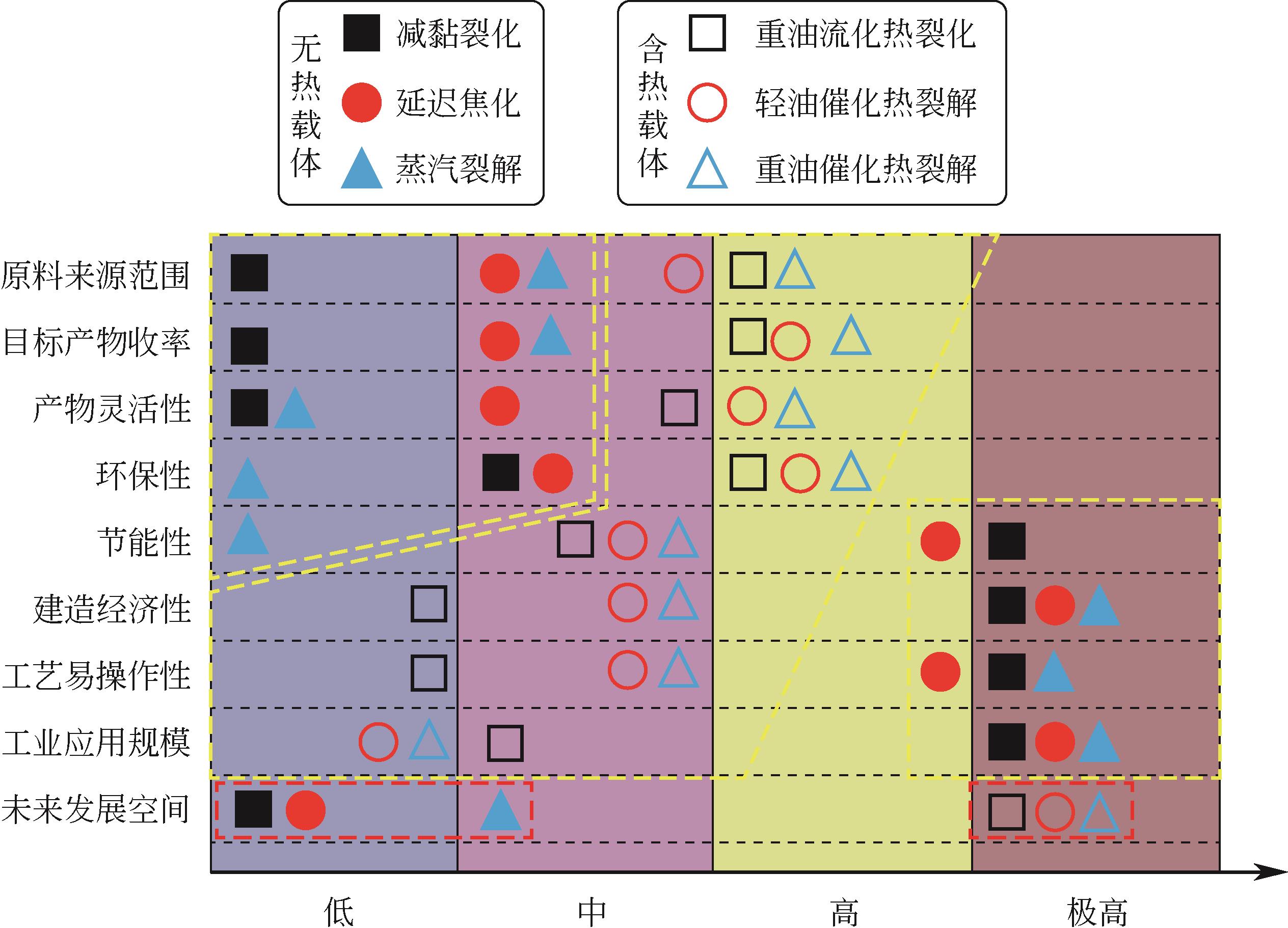化工进展 ›› 2024, Vol. 43 ›› Issue (7): 3534-3550.DOI: 10.16085/j.issn.1000-6613.2024-0441
• 专栏:热化学反应工程技术 • 上一篇
典型石油热加工技术发展现状及展望
- 中国石油大学(北京)机械与储运工程学院,重质油全国重点实验室,北京 102249
-
收稿日期:2024-03-18修回日期:2024-04-23出版日期:2024-07-10发布日期:2024-08-14 -
通讯作者:张玉明 -
作者简介:刘文津(1995—),男,博士研究生,研究方向为燃料热转化。E-mail:lwj15910652331@163.com。 -
基金资助:国家自然科学基金(22278432);中国石油大学(北京)科研基金(2462021QNXZ007)
State of the art and prospect of typical petroleum thermal processing technology
LIU Wenjin( ), ZHANG Yuming(
), ZHANG Yuming( ), LI Jiazhou, ZHANG Wei, CHEN Zhewen
), LI Jiazhou, ZHANG Wei, CHEN Zhewen
- College of Mechanical and Transportation Engineering, State Key Laboratory of Heavy Oil Processing, China University of Petroleum, Beijing 102249, China
-
Received:2024-03-18Revised:2024-04-23Online:2024-07-10Published:2024-08-14 -
Contact:ZHANG Yuming
摘要:
石油热加工技术是在热量作用下使石油及其产物发生热裂化和缩合反应生成不同产品,涉及石油炼制与化工生产的绝大多数加工过程,属于“热化学反应工程”分支之一。随着第三次能源转型持续推进,石油炼制行业正面临“油转化”的重大生产结构调整,促使以热化学反应为核心的石油热加工技术不断发展,包括以重油轻质化为主要目标的减黏裂化、延迟焦化、重油流化热裂化技术以及以低碳烯烃为主要目标的蒸汽裂解技术。为了更为高效地将石油转化为低碳烯烃,将热化学反应进一步与催化反应耦合,发展出含催化热载体的轻油催化热裂解和重油催化热裂解两类热化学-催化耦合热加工技术。本文对上述六种典型石油热加工技术的演变历程、技术特点、发展现状与前景进行了纵向梳理,并从不同维度对其进行横向对比分析。对比发现,热加工中热载体循环再生能够有效解决工艺过程焦炭处理问题,且能与催化反应相耦合,使得重油流化热裂化、轻油催化热裂解和重油催化热裂解等热加工技术在原料适应性、产物灵活性、环保性方面具有突出优势。此外,将电气化技术进一步与蒸汽裂解及以外的其他热加工技术相结合,可有效提升石油热加工领域未来的整体环保性和节能性。
中图分类号:
引用本文
刘文津, 张玉明, 李家州, 张炜, 陈哲文. 典型石油热加工技术发展现状及展望[J]. 化工进展, 2024, 43(7): 3534-3550.
LIU Wenjin, ZHANG Yuming, LI Jiazhou, ZHANG Wei, CHEN Zhewen. State of the art and prospect of typical petroleum thermal processing technology[J]. Chemical Industry and Engineering Progress, 2024, 43(7): 3534-3550.
| 技术名称 | 研发单位 | 反应器 | 热载体 | 裂化器 温度/℃ | 压力 /MPa | 裂化停留时间/s | 裂化器气氛 |
|---|---|---|---|---|---|---|---|
| 延迟焦化[ | 美国标准石油公司率先研发 | 管式炉+焦炭塔 | 无 | 500 | 0.1~0.35 | ≤60 | H2O |
| 流化焦化[ | Exxon Mobile率先研发 | 流化床裂化器+燃烧器 | 热焦粉 | 480~550 | 0.07~0.09 | 1~2 | H2O |
| 灵活焦化[ | Exxon Mobile率先研发 | 流化床裂化器+加热器+气化器 | 热焦粉 | 480~550 | 0.07~0.09 | 1~2 | H2O、H2、CO |
| ART[ | 恩格尔哈德&凯洛格公司 | 流化床裂化器+燃烧器 | 惰性颗粒 | 450~530 | 0.1~0.3 | <2 | H2O、NH3 |
| KKI[ | 日本神户制钢&兴亚石油&出光兴产 | 流化床裂化器+加热器+气化器+还原器 | 铁矿石粉 | 500~560 | 0.5~1 | 0.3~0.8 | H2O |
| OSI[ | 中国石油大学(北京) | 流化床裂化-气化耦合反应器 | 混合热载体 | 450~700 | 0.1 | 1~20 | H2O、H2、CO |
表1 重油流化热裂化与延迟焦化技术对比
| 技术名称 | 研发单位 | 反应器 | 热载体 | 裂化器 温度/℃ | 压力 /MPa | 裂化停留时间/s | 裂化器气氛 |
|---|---|---|---|---|---|---|---|
| 延迟焦化[ | 美国标准石油公司率先研发 | 管式炉+焦炭塔 | 无 | 500 | 0.1~0.35 | ≤60 | H2O |
| 流化焦化[ | Exxon Mobile率先研发 | 流化床裂化器+燃烧器 | 热焦粉 | 480~550 | 0.07~0.09 | 1~2 | H2O |
| 灵活焦化[ | Exxon Mobile率先研发 | 流化床裂化器+加热器+气化器 | 热焦粉 | 480~550 | 0.07~0.09 | 1~2 | H2O、H2、CO |
| ART[ | 恩格尔哈德&凯洛格公司 | 流化床裂化器+燃烧器 | 惰性颗粒 | 450~530 | 0.1~0.3 | <2 | H2O、NH3 |
| KKI[ | 日本神户制钢&兴亚石油&出光兴产 | 流化床裂化器+加热器+气化器+还原器 | 铁矿石粉 | 500~560 | 0.5~1 | 0.3~0.8 | H2O |
| OSI[ | 中国石油大学(北京) | 流化床裂化-气化耦合反应器 | 混合热载体 | 450~700 | 0.1 | 1~20 | H2O、H2、CO |
| 研发单位 | 技术特点 | 应用现状 |
|---|---|---|
| 中国石油大学(北京)[ | 电磁感应加热供能 | 2022年工业示范 |
| Lummus公司[ | 蒸汽裂解炉主要压缩机的蒸汽涡轮部分更换为电动驱动,可实现CO2零排放 | 2022年首次工业化应用 |
| BASF公司、沙特基础工业公司和Linde公司[ | 直接加热,电流直接应用于反应器内的管道; 间接加热,利用放置在管道周围加热电气元件的辐射加热 | 2023年启动建设工业化装置 |
| 中石化上海工程公司和华东理工大学[ | 新型高收率、低排放SH-III型裂解炉 | 2023年完成技术包开发 |
| Coolbrook公司和Linde公司[ | 通过旋转叶片流的空气动力,转化为可再生能源电力给蒸汽裂解炉供能 | 2024年建成首批工业装置 |
| Shell公司和Dow公司[ | 基于理论电气化模型改造现有燃气蒸汽裂解炉 | 2025年开始建造中试装置 |
表2 蒸汽裂解电气化技术研发与应用现状
| 研发单位 | 技术特点 | 应用现状 |
|---|---|---|
| 中国石油大学(北京)[ | 电磁感应加热供能 | 2022年工业示范 |
| Lummus公司[ | 蒸汽裂解炉主要压缩机的蒸汽涡轮部分更换为电动驱动,可实现CO2零排放 | 2022年首次工业化应用 |
| BASF公司、沙特基础工业公司和Linde公司[ | 直接加热,电流直接应用于反应器内的管道; 间接加热,利用放置在管道周围加热电气元件的辐射加热 | 2023年启动建设工业化装置 |
| 中石化上海工程公司和华东理工大学[ | 新型高收率、低排放SH-III型裂解炉 | 2023年完成技术包开发 |
| Coolbrook公司和Linde公司[ | 通过旋转叶片流的空气动力,转化为可再生能源电力给蒸汽裂解炉供能 | 2024年建成首批工业装置 |
| Shell公司和Dow公司[ | 基于理论电气化模型改造现有燃气蒸汽裂解炉 | 2025年开始建造中试装置 |
| 技术名称 | 乙烯 | 丙烯 | 尾气(主要是甲烷) | 丁二烯 | C4抽余油 | 粗汽油 | 焦炭 | 酸性气 | 丙烯/乙烯 | 总烯烃 |
|---|---|---|---|---|---|---|---|---|---|---|
| 蒸汽裂解 | 36.25 | 16.56 | 16.98 | 5.11 | 4.58 | 18.49 | 1.77 | 0.17 | 0.46 | 52.81 |
| ACO催化热裂解 | 31.93 | 29.44 | 15.14 | 0 | 0 | 21.62 | 1.75 | 0.12 | 0.92 | 61.37 |
表3 石脑油蒸汽裂解和ACO技术产物对比(质量收率/%)
| 技术名称 | 乙烯 | 丙烯 | 尾气(主要是甲烷) | 丁二烯 | C4抽余油 | 粗汽油 | 焦炭 | 酸性气 | 丙烯/乙烯 | 总烯烃 |
|---|---|---|---|---|---|---|---|---|---|---|
| 蒸汽裂解 | 36.25 | 16.56 | 16.98 | 5.11 | 4.58 | 18.49 | 1.77 | 0.17 | 0.46 | 52.81 |
| ACO催化热裂解 | 31.93 | 29.44 | 15.14 | 0 | 0 | 21.62 | 1.75 | 0.12 | 0.92 | 61.37 |
技术 名称 | 原料性质 | 操作参数 | 产物分布 | ||||||||||||||||
|---|---|---|---|---|---|---|---|---|---|---|---|---|---|---|---|---|---|---|---|
原料 类型 | 密度(20℃) /g·cm-3 | 康氏 残炭值 | C质量分数 /% | H质量分数 /% | S质量分数 /% | N质量分数 /% | 催化剂类型 | 反应 温度 /℃ | 停留 时间/s | 干气(主要是甲烷) | 乙烯 | 丙烯 | 碳四 烯烃 | 汽油 | 柴油+ 煤油 | 焦炭 | 总低碳烯烃 | 丙烯 /乙烯 | |
| HCC[ | 常压 渣油 | 0.888 | 4.1 | 86.39 | 13.25 | 0.117 | 0.177 | LCM-5 | 670 | 1.5 | 17.33 | 26.1 | 14.99 | 9.13 | — | — | 8.99 | 50.22 | 0.57 |
| CPP[ | 常压 渣油 | 0.8953 | 4.3 | 86.52 | 13.03 | 0.15 | 0.28 | CEP-1(SY) | 640 | <1 | 16.74 | 20.37 | 18.23 | 7.52 | 14.82 | 7.93 | 10.66 | 46.12 | 0.9 |
| DCP[ | 重质 油A | 0.91 | 4.13 | 86.48 | 12.98 | 0.33 | 0.19 | LTD纳米分子筛 | 650 | 0.8 | 1.62 | 3.43 | 20.55 | 19.98 | 26.19 | 10.21 | 8.6 | 43.96 | 5 |
| MDCP[ | 重质 油A | 0.91 | 4.13 | 86.48 | 12.98 | 0.33 | 0.19 | 纳米分子筛 | 一级620/二级670 | 一级0.3/二级0.5 | 7.91 | 16.06 | 24.57 | 10.91 | 14.27 | 9.23 | 9.54 | 51.54 | 1.53 |
表4 典型重油催化热裂解技术产物分布对比
技术 名称 | 原料性质 | 操作参数 | 产物分布 | ||||||||||||||||
|---|---|---|---|---|---|---|---|---|---|---|---|---|---|---|---|---|---|---|---|
原料 类型 | 密度(20℃) /g·cm-3 | 康氏 残炭值 | C质量分数 /% | H质量分数 /% | S质量分数 /% | N质量分数 /% | 催化剂类型 | 反应 温度 /℃ | 停留 时间/s | 干气(主要是甲烷) | 乙烯 | 丙烯 | 碳四 烯烃 | 汽油 | 柴油+ 煤油 | 焦炭 | 总低碳烯烃 | 丙烯 /乙烯 | |
| HCC[ | 常压 渣油 | 0.888 | 4.1 | 86.39 | 13.25 | 0.117 | 0.177 | LCM-5 | 670 | 1.5 | 17.33 | 26.1 | 14.99 | 9.13 | — | — | 8.99 | 50.22 | 0.57 |
| CPP[ | 常压 渣油 | 0.8953 | 4.3 | 86.52 | 13.03 | 0.15 | 0.28 | CEP-1(SY) | 640 | <1 | 16.74 | 20.37 | 18.23 | 7.52 | 14.82 | 7.93 | 10.66 | 46.12 | 0.9 |
| DCP[ | 重质 油A | 0.91 | 4.13 | 86.48 | 12.98 | 0.33 | 0.19 | LTD纳米分子筛 | 650 | 0.8 | 1.62 | 3.43 | 20.55 | 19.98 | 26.19 | 10.21 | 8.6 | 43.96 | 5 |
| MDCP[ | 重质 油A | 0.91 | 4.13 | 86.48 | 12.98 | 0.33 | 0.19 | 纳米分子筛 | 一级620/二级670 | 一级0.3/二级0.5 | 7.91 | 16.06 | 24.57 | 10.91 | 14.27 | 9.23 | 9.54 | 51.54 | 1.53 |
| 46 | SCHUMACHER M M. Heavy oil and tar sands recovery and upgrading[M]. Park Ridge, New Jersey, USA: Noyes Data Co, 1982: 512-522. |
| 47 | LAN Xingying, ZHANG Yuming, GAO Jinsen, et al. Integrated method and apparatus for catalytic cracking of heavy oil and production of syngas: US11230674[P]. 2022-01-25. |
| 48 | XIONG Qingan, ZHANG Yuming, HUANG Youjian, et al. Fundamental study of the integrated process of heavy oil pyrolysis and coke gasification. Part Ⅰ: Effect of CO and H2 in syngas atmosphere on heavy oil pyrolysis[J]. Fuel, 2022, 324: 124650. |
| 49 | LAN Xingying, ZHANG Yuming, GAO Jinsen, et al. Coupling reaction apparatus for heavy oil pyrolysis-gasification: US20210087475[P]. 2021-03-25. |
| 50 | 田原宇, 乔英云, 刘锋. 劣质重油加工技术的挑战与对策——轻型乘用车电动化对重质油加工的影响[J]. 石油与天然气化工, 2013, 42(5): 463-467. |
| TIAN Yuanyu, QIAO Yingyun, LIU Feng. Challenges and countermeasures of inferior quality heavy oil processing technology: Effects of light passenger car electrifying on heavy oil processing[J]. Chemical Engineering of Oil & Gas, 2013, 42(5): 463-467. | |
| 51 | BARTHOLIC David B. Upgrading petroleum and residual fractions thereof: US4263128[P]. 1981-04-21. |
| 52 | MORI K, 郭雨东, 宗瞻千. KKI工艺: 残渣油热裂解与生产海绵铁联合工艺, 以副产焦炭作还原剂[J]. 化学工业与工程, 1986, 3(4): 74-79. |
| MORI K, GUO Yudong, ZONG Zhanqian. KKI process: A combined process of pyrolysis of residual oil and production of sponge iron, with by-product coke as reducing agent[J]. Chemical Industry and Engineering, 1986, 3(4): 74-79. | |
| 53 | KENJI Mori, MAMORU Onoda, MAKOTO Watanabe, et al. Preparation of high-concentration hydrogen gas with thermal cracking of heavy oil: JPS6142590A[P]. 1984-08-03. |
| 54 | ZACHAROPOULOU Vasiliki, LEMONIDOU Angeliki. Olefins from biomass intermediates: A review[J]. Catalysts, 2018, 8(1): 2. |
| 55 | BENDER Michael. An overview of industrial processes for the production of olefins-C4 hydrocarbons[J]. ChemBioEng Reviews, 2014, 1(4): 136-147. |
| 56 | 肖仕辉, 王丽, 易广坤, 等. 乙烯工业发展现状及分析[J]. 生物化工, 2023, 9(3): 190-197. |
| XIAO Shihui, WANG Li, YI Guangkun, et al. Current situation and analysis of ethylene industry development[J]. Biological Chemical Engineering, 2023, 9(3): 190-197. | |
| 57 | 王小强, 蔡小霞, 景媛媛, 等. 蒸汽裂解生产乙烯的原料优化选择与配置[J]. 石油与天然气化工, 2024, 53(1): 47-53. |
| WANG Xiaoqiang, CAI Xiaoxia, JING Yuanyuan, et al. Optimal selection and configuration of feedstock for ethylene by steam cracking[J]. Chemical Engineering of Oil & Gas, 2024, 53(1): 47-53. | |
| 58 | CORMA A, CORRESA E, MATHIEU Y, et al. Crude oil to chemicals: Light olefins from crude oil[J]. Catalysis Science & Technology, 2017, 7(1): 12-46. |
| 59 | 吴青. 原油(重油)制化学品的技术及其进展——Ⅰ.原油蒸汽裂解技术[J]. 炼油技术与工程, 2022, 52(4): 1-10. |
| WU Qing. Technology and progress in crude oil to chemicals Part one: Crude oil steam cracking technology[J]. Petroleum Refinery Engineering, 2022, 52(4): 1-10. | |
| 60 | D·B·思百斯, A·R·迪尼克兰托尼奥, J·M·弗莱伊, 等. 烃原料的蒸汽裂化方法和设备: CN101796167A[P]. 2010-08-04. |
| SPICER D B, DINICKLAND TONIO A R, FLEE J M, et al. Steam cracking method and equipment for hydrocarbon raw materials: CN101796167A[P]. 2010-08-04. | |
| 61 | J·N·麦克考伊, D·B·斯派瑟, R·C·斯蒂尔. 蒸汽裂解重质烃原料的方法: CN1934226A[P]. 2007-03-21. |
| MCCOY J N, SPICER D B, STEELE R C. Method for steam cracking of heavy hydrocarbon raw materials: CN1934226A[P]. 2007-03-21. | |
| 62 | KHARE G, ARNE M. IHS chemical PEP report 29J: steam cracking of crude oil[R]. IHS, 2015. |
| 63 | 中国石化有机原料科技情报中心站. 鲁姆斯公司的原油热解制化学品技术首次应用[J]. 石油炼制与化工, 2023, 54(4): 124. |
| Sinopec organic raw material science and Technology Information Center station.The first application of Rhuems Company’s crude oil pyrolysis technology to produce chemicals[J]. Petroleum Processing and Petrochemicals, 2023, 54(4): 124. | |
| 64 | ZAHRA Gholami, FATEMEH Gholami, Tišler ZDENĚK, et al. A review on the production of light olefins using steam cracking of hydrocarbons[J]. Energies, 2021, 14(23): 8190. |
| 65 | 蒲田, 胡建清, 周红军, 等. 炼化工业碳减排路径与电化工/电供能技术发展综述[J]. 石油科学通报, 2023, 8(4): 445-460. |
| PU Tian, HU Jianqing, ZHOU Hongjun, et al. Low-carbon pathways and electrochemical/electrification technologies development in the refining-chemical industry: A review[J]. Petroleum Science Bulletin, 2023, 8(4): 445-460. | |
| 66 | 中国石化有机原料科技情报中心站. Coolbrook与林德工程公司推进蒸汽裂解电气化技术开发[J]. 石油炼制与化工, 2023, 54(6): 83. |
| Sinopec Organic Raw Material Science and Technology Information Center station. Coolbrook and linde engineering company promote the development of steam cracking electrification technology[J]. Petroleum Processing and Petrochemicals, 2023, 54(6): 83. | |
| 67 | 周红军, 周颖, 徐春明. 中国碳达峰碳中和目标下炼化一体化新路径与实践[J]. 化工进展, 2022, 41(4): 2226-2230. |
| ZHOU Hongjun, ZHOU Ying, XU Chunming. Exploration of refining and chemical integration under China’s dualcarbon target[J]. Chemical Industry and Engineering Progress, 2022, 41(4): 2226-2230. | |
| 68 | 周红军, 宋红梅, 毕凤云, 等. 一种利用电供能的蒸汽裂解方法: CN114602415A[P]. 2022-06-10. |
| ZHOU Hongjun, Song Hongmei, Bi Fengyun, et al. A steam cracking method using electric supply: CN114602415A[P]. 2022-06-10. | |
| 69 | 贺美晋. Lummus公司推出首个净零碳排放乙烷裂解装置[J]. 石油炼制与化工, 2022, 53(11): 41. |
| 1 | XU Guangwen, BAI Dingrong, XU Chunming, et al. Challenges and opportunities for engineering thermochemistry in carbon-neutralization technologies[J]. National Science Review, 2022, 10(9): nwac217. |
| 2 | GUO Zhancheng, WANG Shiwei, BAI Dingrong. Engineering thermochemistry: The science critical for the paradigm shift toward carbon neutrality[J]. Resources Chemicals and Materials, 2023, 2(4): 331-334. |
| 3 | HAN Zhennan, JIA Xin, SONG Xingfei, et al. Engineering thermochemistry to cope with challenges in carbon neutrality[J]. Journal of Cleaner Production, 2023, 416: 137943. |
| 4 | 韩雪松. 延迟焦化工艺技术进展浅析[J]. 当代石油石化, 2015, 23(10): 12-17. |
| HAN Xuesong. The brief discussion about the progress of delayed coking process technology[J]. Petroleum & Petrochemical Today, 2015, 23(10): 12-17. | |
| 5 | OPEC. World oil outlook[R]. Vienna: OPEC, 2018. |
| 6 | 熊昊, 梁潇予, 张晨曦, 等. 重质油直接制化工品:多级逆流下行催化裂解技术[J]. 化工学报, 2023, 74(1): 86-104. |
| XIONG Hao, LIANG Xiaoyu, ZHANG Chenxi, et al. Heavy oil to chemicals: Multi-stage downer catalytic pyrolysis[J]. CIESC Journal, 2023, 74(1): 86-104. | |
| 7 | SPEIGHT J G. The chemistry and technology of petroleum[M]. 5th ed. Boca Raton: CRC Press, 2014: 482. |
| 8 | RICE F O, HERZFELD K F. The thermal decomposition of organic compounds from the standpoint of free radicals. Ⅵ. the mechanism of some chain reactions[J]. Journal of the American Chemical Society, 1934, 56(2): 284-289. |
| 9 | KUBOTA Narimi, KAJIWARA Atsushi, ZETTERLUND Per B, et al. Determination of the propagation rate coefficient of vinyl pivalate based on EPR quantification of the propagating radical concentration[J]. Macromolecular Chemistry and Physics, 2010, 208(22): 2403-2411. |
| 10 | 李雨萧, 王青月, Lim Khak Ho, 等. 自由基聚合反应动力学常数测定技术[J]. 化工学报, 2023, 74(2): 559-570. |
| 69 | HE Meijin. Lummus introduced the first ethane cracking unit with zero net carbon emission[J]. Petroleum Processing and Petrochemicals, 2022, 53(11): 41. |
| 70 | STEPHAN Dominik. 蒸汽裂解炉装置的电气化[J]. 流程工业, 2023(3): 22-23. |
| STEPHAN Dominik.Electrification of steam cracking furnace device[J]. Process, 2023(3): 22-23. | |
| 71 | 许慎艳. 上海工程公司百万吨级绿色高效蒸汽裂解制乙烯工艺包通过专家审查[J]. 化工设备与管道, 2023, 60(2): 5. |
| XU Shenyan. Shanghai Engineering Company’s million-ton green and efficient steam cracking process package for ethylene production passed the expert review[J]. Process Equipment & Piping, 2023, 60(2): 5. | |
| 72 | 张伟清. 壳牌公司和陶氏公司启动电加热裂解炉试验装置[J]. 石油炼制与化工, 2022, 53(9): 114. |
| ZHANG Weiqing. Shell and Dow started the electric heating cracking furnace test device[J]. Petroleum Processing and Petrochemicals, 2022, 53(9): 114. | |
| 73 | 许友好, 左严芬, 白旭辉, 等. 靶向生产低碳烯烃的催化裂化技术开发背景、思路和概念设计[J]. 石油炼制与化工, 2021, 52(8): 1-11. |
| XU Youhao, ZUO Yanfen, BAI Xuhui, et al. Development background, development idea and conceptual design of FCC process for targeted cracking to light olefins[J]. Petroleum Processing and Petrochemicals, 2021, 52(8): 1-11. | |
| 74 | 刘剑, 孙淑坤, 张永军, 等. 石脑油催化裂解制低碳烯烃技术进展及其技术经济分析[J]. 化学工业, 2011, 29(11): 33-36. |
| LIU Jian, SUN Shukun, ZHANG Yongjun, et al. Advance in catalytic cracking of naphtha to light olefins and techno-economic analysis[J]. Chemical Industry, 2011, 29(11): 33-36. | |
| 75 | 彭琳. 日本丸善公司和AIST正在开发石脑油的催化裂解工艺[J]. 国内外石油化工快报, 2007, 37(2): 17. |
| 10 | LI Yuxiao, WANG Qingyue, Lim Khak HO, et al. Characterization technique for kinetic coefficients of free radical polymerization[J]. CIESC Journal, 2023, 74(2): 559-570. |
| 11 | 王才良, 周珊. 炼油工艺技术发展史话[J]. 石油知识, 2013(2): 32-36. |
| WANG Cailiang, ZHOU Shan. History of refining technology development[J]. Petroleum Knowledge, 2013(2): 32-36. | |
| 12 | ELLIS Paul J, PAUL Christopher A. Tutorial: Delayed Coking Fundamentals[M]. New York: American institute of chemical engineers, 2005: 5. |
| 13 | 亓玉台, 谢传欣, 李会鹏, 等. 减黏裂化工艺技术及其进展[J]. 炼油设计, 2000, 30(10): 1-6. |
| QI Yutai, XIE Chuanxin, LI Huipeng, et al. Progress in visbreaking technology[J]. Petroleum Refinery Engineering, 2000, 30(10): 1-6. | |
| 14 | 袁明江, 肖立刚, 张晓光. 灵活焦化装置对炼油厂规划设计的影响[J]. 石油炼制与化工, 2013, 44(2): 57-60. |
| YUAN Mingjiang, XIAO Ligang, ZHANG Xiaoguang. The influence of flexi-coking technology on refinery planning and designing[J]. Petroleum Processing and Petrochemicals, 2013, 44(2): 57-60. | |
| 15 | 国内信息.中油建成国内第一套HCC装置[J]. 石油化工设计, 2002, 19(1): 25. |
| information Domestic. Domestic information. CNPC has built the first set of HCC[J]. Petrochemical Design, 2002, 19(1): 25. | |
| 16 | 黄兴山. 全球首套50×104t/a CPP工业化装置在沈阳投产[J]. 中外能源, 2009, 14(9): 107. |
| HUANG Xingshan. The world’s first 50 ×104t/a CPP industrial plant was put into operation in Shenyang[J]. Sino-Global Energy, 2009, 14(9): 107. | |
| 75 | PENG Lin. Maru Sun of Japan and AIST are developing the catalytic cracking process for naphtha[J]. Domestic And Foreign Petrochemical Express, 2007,37 (2): 17 |
| 76 | 李剑, 张建国. 石脑油催化裂解制丙烯工艺与催化剂的研究[J]. 石油化工, 2010, 39(): 118-121. |
| LI Jian, ZHANG Jianguo. Research on the process and catalyst of catalytic cracking to propylene in naphtha[J]. Petrochemical Technology, 2010, 39 (): 118-121. | |
| 77 | 谢朝钢. 催化热裂解生产乙烯技术的研究及反应机理的探讨[J]. 石油炼制与化工, 2000, 31(7): 40-44. |
| XIE Chaogang. Studies on catalytic pyrolysis process for ethylene production and its reaction mechanism[J]. Petroleum Processing and Petrochemicals, 2000, 31(7): 40-44. | |
| 78 | 王明党, 沙颖逊, 崔中强, 等. 重油接触裂解制乙烯的HCC工艺研究[J]. 河南石油, 2002, 16(3): 50-52, 4. |
| WANG Mingdang, SHA Yingxun, CUI Zhongqiang, et al. A research on HCC process for ethylene Manu-facturing[J]. Henan Petroleum, 2002, 16(3): 50-52, 4. | |
| 79 | 王大壮, 王鹤洲, 谢朝钢, 等. 重油催化热裂解(CPP)制烯烃成套技术的工业应用[J]. 石油炼制与化工, 2013, 44(1): 56-59. |
| WANG Dazhuang, WANG Hezhou, XIE Chaogang, et al. Commercial trial of cpp complete technology for producing light olefins from heavy feedstock[J]. Petroleum Processing and Petrochemicals, 2013, 44(1): 56-59. | |
| 80 | DENG Rensheng, WEI Fei, JIN Yan, et al. Downer catalytic pyrolysis (DCP): a novel process for light olefins production[J]. Chemical Engineering Technology, 2002, 25(7): 711-716. |
| 81 | PARTHASARATHI R S, ALABDULJABBAR Sarah S. HS-FCC High-severity fluidized catalytic cracking: A newcomer to the FCC family[J]. Applied Petrochemical Research, 2014, 4(4): 441-444. |
| 82 | ZHANG Jinhong, CHE Yuanjun, WANG Zhenbo, et al. Coupling process of heavy oil millisecond pyrolysis and coke gasification: a fundamental study[J]. Energy & Fuels, 2016, 30(8): 6698-6708. |
| 17 | 白玫. ACO技术制备烯烃工艺研究及展望[J]. 化工与医药工程, 2017, 38(3): 18-23. |
| BAI Mei. Research of ACO technique used in preparation of olefins and expectation[J]. Chemical and Pharmaceutical Engineering, 2017, 38(3): 18-23. | |
| 18 | 宋昌才, 邓中活, 牛传峰. 重油生产低碳烯烃等化工品技术研究进展[J]. 化工进展, 2019, 38(S1): 86-94. |
| SONG Changcai, DENG Zhonghuo, NIU Chuanfeng. Advances in production of chemicals such as light oilfins from heavy oil[J]. Chemical Industry and Engineering Progress, 2019, 38(S1): 86-94. | |
| 19 | 中国石化报.SEI原油蒸汽裂解技术首次工业化应用成功[J]. 乙烯工业, 2022, 34(1):58. |
| China Petrechemical News. The first industrial application of steam cracking technology of crude oil in China was successful[J]. Ethylene Industry, 2022, 34(1):58. | |
| 20 | LIU Jun, XING Yu, CHEN Yixiao, et al. Visbreaking of heavy oil under supercritical water environment[J]. Industrial & Engineering Chemistry Research, 2018, 57(3): 867-875. |
| 21 | 谢传欣, 亓玉台, 孙大勇, 等. 减黏裂化工艺技术及进展(Ⅱ)——减黏裂化工艺进展及发展趋势[J]. 抚顺石油学院学报, 2000, 20(2): 3-8. |
| XIE Chuanxin, QI Yutai, SUN Dayong, et al. Visbreaking technology and evolement ( Ⅱ ) —Visbreaking technical evolvement and developing trend[J]. Journal of Fushun Petroleum Institute, 2000, 20(2): 3-8. | |
| 22 | SPEIGHT J G. Visbreaking: A technology of the past and the future[J]. Scientia Iranica, 2012, 19(3): 569-573. |
| 23 | J-Philippe LEININGER, MINOT Christian, LORANT François, et al. Density functional theory investigation of competitive free-radical processes during the thermal cracking of methylated polyaromatics: Estimation of kinetic parameters[J]. The Journal of Physical Chemistry A, 2007, 111(16): 3082-3090. |
| 24 | HEMELSOET Karen, MORAN Damian, VAN SPEYBROECK Veronique, et al. An assessment of theoretical procedures for predicting the thermochemistry and kinetics of hydrogen abstraction by methyl radical from benzene[J]. The Journal of Physical Chemistry A, 2006, 110(28): 8942-8951. |
| 25 | 王军, 马海彬, 朱辉煌. 增产优质石油焦的原理及方法浅析[J]. 石油化工技术与经济, 2023, 39(5): 53-56. |
| WANG Jun, MA Haibin, ZHU Huihuang. A tentative analysis on the principle and method of increasing output of high-quality petroleum coke[J]. Technology & Economics in Petrochemicals, 2023, 39(5): 53-56. | |
| 26 | 李出和. 国内外延迟焦化技术对比[J]. 石油炼制与化工, 2010, 41(1): 1-5. |
| LI Chuhe. A review and comparison of delayed coking technology[J]. Petroleum Processing and Petrochemicals, 2010, 41(1): 1-5. | |
| 27 | 李出和, 李卓, 袁志祥. 2.5Mt/a延迟焦化装置的设计与运行探析[J]. 石油化工设计, 2010, 27(1): 1-4, 4. |
| LI Chuhe, LI Zhuo, YUAN Zhixiang. Summary on the design and operation of 2.5Mt/a delayed coker unit[J]. Petrochemical Design, 2010, 27(1): 1-4, 4. | |
| 28 | 曹玉亭, 刘宇飞. 重油延迟焦化发展现状及展望[J]. 天然气与石油, 2010, 28(5): 30-33, 82. |
| CAO Yuting, LIU Yufei. Development status and prospect on delay coking of heavy oil[J]. Natural Gas and Oil, 2010, 28(5): 30-33, 82. | |
| 29 | 孙在春, 苏君雅, 杨继涛. 循环比对胜利渣油焦化行为的影响[J]. 石油学报(石油加工), 1997, 13(4): 10-16. |
| SUN Zaichun, SU Junya, YANG Jitao. Influence of throughput patio on the coking behaviour of Shengli vacuum residue[J]. Acta Petrolei Sinica (Petroleum Processing Section), 1997, 13(4): 10-16. | |
| 30 | 刘方涛. 延迟焦化技术的现状及展望[J]. 广州化工, 2010, 38(1): 27-29, 32. |
| LIU Fangtao. Status and development prospect of delayed coking technology[J]. Guangzhou Chemical Industry, 2010, 38(1): 27-29, 32. | |
| 83 | CHE Yuanjun, YUAN Meng, QIAO Yingyun, et al. Fundamental study of hierarchical millisecond gas-phase catalytic cracking process for enhancing the production of light olefins from vacuum residue[J]. Fuel, 2019, 237: 1-9. |
| 84 | 沙颖逊, 崔中强, 王明党, 等. 重油直接裂解制乙烯技术的开发[J]. 炼油设计, 2000, 30(1): 16-18. |
| SHA Yingxun, CUI Zhongqiang, WANG Mingdang, et al. Development of ethylene production using heavy oil contact cracking process[J]. Petroleum Refinery Engineering, 2000, 30(1): 16-18. | |
| 85 | 郭慕孙, 李洪钟. 流态化手册[M]. 北京: 化学工业出版社, 2008. |
| GUO Musun, LI Hongzhong. Handbook of fluidization[M]. Beijing: Chemical Industry Press, 2008. | |
| 86 | 侯凯军, 高金森, 马安, 等. 重油催化裂解制低碳烯烃工艺技术研究进展[J]. 应用化工, 2022, 51(11): 3278-3284. |
| HOU Kaijun, GAO Jinsen, MA An, et al. Research progress in heavy oil catalytic pyrolysis technology for light olefins[J]. Applied Chemical Industry, 2022, 51(11): 3278-3284. | |
| 31 | 肖家治, 赵日峰, 沈国平, 等. 具有变径管的延迟焦化炉: CN201842818U[P]. 2011-05-25. |
| XIAO Jiazhi, ZHAO Rifeng, SHEN Guoping, et al. Delayed coking furnace with variable diameter pipe: CN201842818U[P]. 2011-05-25. | |
| 32 | 肖家治, 赵日峰, 沈国平, 等. 具有贴墙燃烧结构的延迟焦化加热炉: CN201842819U[P]. 2011-05-25. |
| XIAO Jiazhi, ZHAO Rifeng, SHEN Guoping, et al. Delayed coking heating furnace with a wall-mounted combustion structure: CN201842819U[P]. 2011-05-25. | |
| 33 | 罗莹, 孙毅, 周桂娟, 等. 一种管式加热炉: CN201688694U[P]. 2010-12-29. |
| LUO Ying, SUN Yi, ZHOU Guijuan, et al. A tubular heating furnace: CN201688694U[P]. 2010-12-29. | |
| 34 | WIEHE Irwin A, GORBATY Martin L, OLMSTEAD William N. Addition of radical initiators to resid conversion processes: US5006223[P]. 1991-04-09. |
| 35 | COTTE Edgar A, MACHIN Ivan C. Additives for improving thermal conversion of heavy crude oil: US20040031726[P]. 2004-02-19. |
| 36 | SHIH Stuart S, ANGEVINE Philip J. Coking process by addition of free radical inhibitors: US4378288[P]. 1983-03-29. |
| 37 | 王祖纲, 杨勇, 肖家治. 重油加工脱碳技术的发展现状与趋势[J]. 世界石油工业, 2021, 28(2): 53-62. |
| WANG Zugang, YANG Yong, XIAO Jiazhi. Development and prospect of decarburization technology in heavy oil processing[J]. World Petroleum Industry, 2021, 28(2): 53-62. | |
| 38 | 刘建锟, 杨涛, 郭蓉, 等. 解决高硫石油焦出路的措施分析[J]. 化工进展, 2017, 36(7): 2417-2427. |
| LIU Jiankun, YANG Tao, GUO Rong, et al. Analysis of measures to solve high sulfur petroleum coke[J]. Chemical Industry and Engineering Progress, 2017, 36(7): 2417-2427. | |
| 39 | 王亚新, 祁军, 张龙. 我国流态化焦化技术研究进展[J]. 当代化工, 2012, 41(5): 512-515. |
| WANG Yaxin, QI Jun, ZHANG Long. Research progress of domestic fluid coking technology[J]. Contemporary Chemical Industry, 2012, 41(5): 512-515. | |
| 40 | 康建新, 申海平. 流态化焦化的发展概况[J]. 炭素技术, 2006, 25(3): 28-33. |
| KANG Jianxin, SHEN Haiping. Development of fluid coking[J]. Carbon Techniques, 2006, 25(3): 28-33. | |
| 41 | MOLSTEDT B V, MOSER J F. Fluid coking development: A mechanically fluidized reactor[J]. Industrial & Engineering Chemistry, 1958, 50(1): 21-23. |
| 42 | 罗艳托. 石油焦市场发展趋势概述[J]. 石油规划设计, 2008, 19(6): 10-11, 39, 48. |
| LUO Yantuo. Trends of petroleum coke market development[J]. Petroleum Planning & Engineering, 2008, 19(6): 10-11, 39, 48. | |
| 43 | ZHANG Huaihao, CHEN Jinfu, GUO Shaohui. Preparation of natural gas adsorbents from high-sulfur petroleum coke[J]. Fuel, 2008, 87(3): 304-311. |
| 44 | 吴琼, 申云生, 马海燕, 等. 一种重质油灵活焦化加工技术[J]. 当代化工, 2018, 47(8): 1729-1731. |
| WU Qiong, SHEN Yunsheng, MA Haiyan, et al. A kind of heavy oil flexible coking technology[J]. Contemporary Chemical Industry, 2018, 47(8): 1729-1731. | |
| 45 | ALLAN D E, BLASTER D E. Flexicoking of residua with synthescs gas production[C]//NPRA Anuual Meeting. San Antonio, texas: 1982. |
| [1] | 周秋明, 牛丛丛, 吕帅帅, 李红伟, 文富利, 徐润, 李明丰. 通过产物转化分离推动CO2加氢制甲醇过程的研究进展[J]. 化工进展, 2024, 43(5): 2776-2785. |
| [2] | 刘美佳, 王刚, 张忠东, 何盛宝, 高金森. 石蜡基原油直接催化裂解制低碳烯烃新型炼化工艺的开发[J]. 化工进展, 2023, 42(10): 5191-5199. |
| [3] | 胡文德, 王仰东, 王传明. 合成气直接催化转化制低碳烯烃研究进展[J]. 化工进展, 2022, 41(9): 4754-4766. |
| [4] | 张鹏, 孟凡会, 杨贵楠, 李忠. 金属氧化物在OX-ZEO催化剂中催化CO x 加氢制低碳烯烃研究进展[J]. 化工进展, 2022, 41(8): 4159-4172. |
| [5] | 毕文菲, 代成义, 李雪梅, 贺建勋, 赵彬然, 马晓迅. 等离子体与Cu-Pd/S-1催化剂协同催化甲烷转化制低碳烯烃[J]. 化工进展, 2022, 41(1): 227-236. |
| [6] | 孔维杰, 杨春亮, 卜婷婷, 周金波. 碳基硼基催化体系丙烷氧化脱氢催化剂的研究进展[J]. 化工进展, 2021, 40(S1): 223-230. |
| [7] | 刘义涛, 朱明辉, 杨子旭, 孟博, 涂维峰, 韩一帆. 煤制化学品:合成气直接制低碳烯烃催化剂研究进展[J]. 化工进展, 2021, 40(2): 594-604. |
| [8] | 陈静宇,张建红,盛浩,吴大凯,高新华,马清祥,张建利,范素兵,赵天生. CuZnTiO2/SAPO-34双功能催化剂的设计、制备及其用于CO2加氢制烯烃性能[J]. 化工进展, 2020, 39(2): 567-576. |
| [9] | 代成义, 陈中顺, 杜康, 赵潇, 时一鸣, 陈星月, 刘丹, 马晓迅. 甲醇制芳烃催化剂及相关工艺研究进展[J]. 化工进展, 2020, 39(12): 5029-5041. |
| [10] | 刘丹, 陈星月, 时一鸣, 代成义, 马晓迅. 甲醇制对二甲苯联产低碳烯烃改性ZSM-5催化剂在流化床中的反应性能[J]. 化工进展, 2020, 39(11): 4488-4496. |
| [11] | 李琦,张强,赵慧莹,陈志,宋进喜,延卫. 纳米片Ga-MFI分子筛合成及其对航空燃油催化裂解反应中低碳烯烃选择性的影响[J]. 化工进展, 2019, 38(9): 4075-4084. |
| [12] | 王玲玉,韩文锋,刘化章,杨霞珍. 合成气制低碳烯烃铁催化剂活性相的研究进展[J]. 化工进展, 2019, 38(11): 4949-4955. |
| [13] | 马光远, 徐艳飞, 王捷, 王琼, 郑荣贵, 定明月. 合成气直接法制取低碳烯烃铁基催化体系研究进展[J]. 化工进展, 2018, 37(03): 992-1000. |
| [14] | 罗俊, 邵敬爱, 杨海平, 陈应泉, 杨明法, 陈汉平. 生物质催化热解制备低碳烯烃的研究进展[J]. 化工进展, 2017, 36(05): 1555-1564. |
| [15] | 程金燮, 胡志彪, 王科, 邹鑫, 徐晓峰, 李倩, 黄宏, 吴熙宇. 我国合成气一步法制低碳烯烃催化剂研究新进展[J]. 化工进展, 2016, 35(08): 2439-2445. |
| 阅读次数 | ||||||
|
全文 |
|
|||||
|
摘要 |
|
|||||
